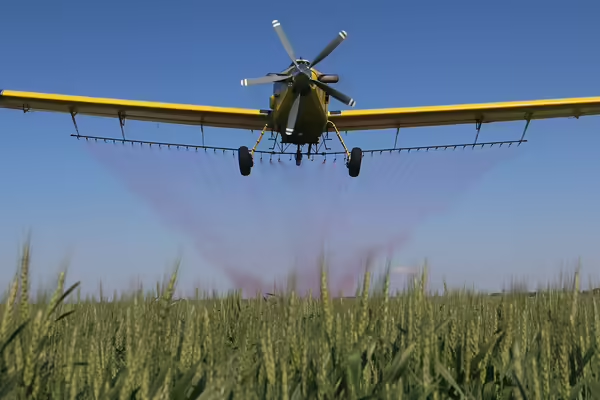
URBANA, Ill. – This year, nearly all of Illinois has experienced hot and humid conditions that can lead to fungal pathogens and insect pests in crops. Farmers can use ground equipment to apply fungicides or insecticides, but the machinery is slow and can injure crops. So, to protect their yield, farmers turn to the skies and aerial applicators.
Every year before to the spray season, University of Illinois Extension staff host fly-ins across the state to technically assist aerial applicators with calibrating their aircraft to apply pesticides safely and uniformly. Using tracer dye, pilots fly several passes over specialized collectors to test droplet size and characterize their spray pattern. With results processed onsite, applicators can make adjustments and retest as needed.
Matt Gill is an Extension specialist in application technology for the Pesticide Safety Education Program who conducts these aerial calibration clinics. He says about a quarter of all pesticides used on agricultural crops and forests across the U.S. are applied by an aircraft.
“It is a credit to the professionalism of Illinois’ aerial applicators that they prioritize safety and application accuracy so highly,” says Gill, adding that pilots bring in their aircraft for testing voluntarily. “Effectively calibrating and pattern testing even a single aircraft can positively impact tens of thousands of acres throughout a spraying season.”
Fly-Ins are a component of Operation S.A.F.E., Self-Regulating Application and Flight Efficiency), a program through the National Agricultural Aviation Research and Education Foundation. Alongside the Illinois Agricultural Aviation Association, Illinois Extension conducted four fly-ins this summer testing 30 aircraft which flew 168 test passes. Illinois Extension staff were also invited to conduct fly-ins in Wisconsin and North Carolina.
“It is immensely encouraging to see aerial applicators continue to push the envelope of technology in pursuit of improving safety and efficacy of their applications,” Gill says.
The fly-ins are also an opportunity for ongoing experimentation. This year, several pilots tested applications at different heights, addressing the public misconception that the lowest applications are best.
“Applicators are often requested to spray with “wheels [or skids] in the tassels,” Gill says “The reality is that every aircraft has an optimal spray height, typically somewhere between 10 to 15 feet above the canopy.”
Flying too low inhibits the spray pattern from developing to its full width and can result in non-uniform application.
The Illinois Department of Agriculture has an aerial pesticide applications FAQ website at bit.ly/3c1f5Ap. The National Pesticide Information Center can provide detailed information on products, product safety information, and information about toxicity risk. NPIC toxicologists can be reached at npic.orst.edu or by calling 1-800-858-7378 from 11 a.m. to 2 p.m. CT.
Explore more in the Illinois Pesticide Review newsletter provided by the University of Illinois Pesticide Safety Education Program.
PHOTO ACCESS: The photo in this article is available to download for media use.
Photo by Matt Gill, University of Illinois. An Air Tractor AT-802A does pattern testing at a Fly-In event hosted by Illinois Extension.
Illinois Extension leads public outreach for University of Illinois by translating research into action plans that allow Illinois families, businesses, and community leaders to solve problems, make informed decisions, and adapt to changes and opportunities.